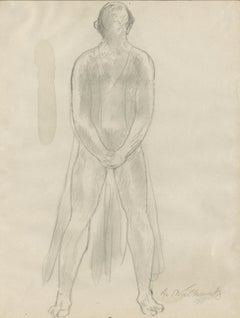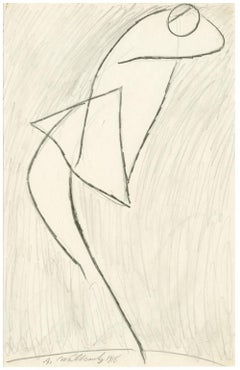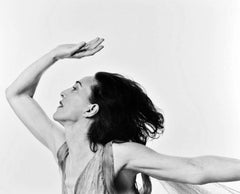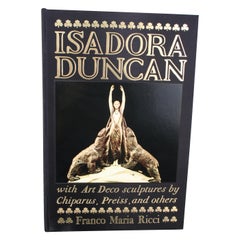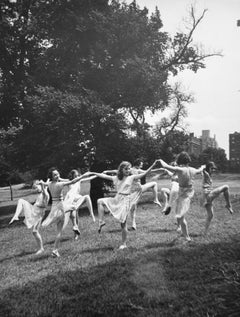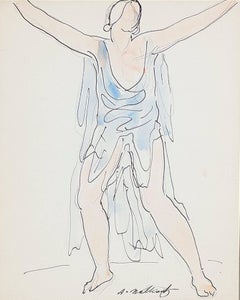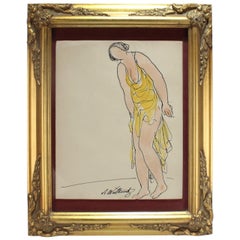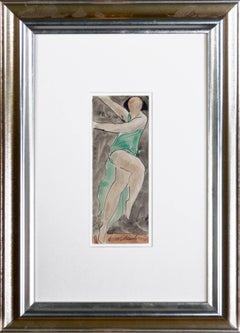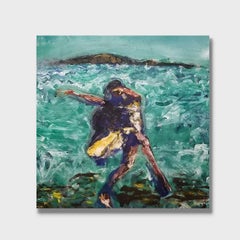Isadora Duncan
to
25
126
115
233
113
65
39
31
29
26
20
17
14
9
6
5
4
4
3
3
3
3
1
42
42
42
33
11
Sort By
Isadora Duncan
By Abraham Walkowitz
Located in Fairlawn, OH
Isadora Duncan
Graphite with grey wash on paper mounted to cardstock
Signed and dated in pencil
Category
1910s American Modern Figurative Drawings and Watercolors
Materials
Graphite
Untitled (Figurative Abstraction of Isadora Duncan #7)
By Abraham Walkowitz
Located in Myrtle Beach, SC
Abraham Walkowitz, Untitled (Figurative Abstraction of Isadora Duncan #7), pencil, 1918. Signed and
Category
1910s American Modern Figurative Drawings and Watercolors
Materials
Pencil
$550
H 10.5 in W 6.75 in D 0.01 in
Isadora Duncan dancer Lori Belilove performing
By Jack Mitchell
Located in Senoia, GA
11 x 14" vintage silver gelatin photograph of Isadora Duncan dancer Lori Belilove performing in
Category
Early 2000s Pop Art Black and White Photography
Materials
Silver Gelatin
$1,200 Sale Price
20% Off
H 11 in W 14 in D 0.03 in
Art Deco Collectors Book, Limited # 2459/3000 Never Opened Isadora Duncan Life
Located in Los Angeles, CA
best deco figurines and tells the story of Isadora Duncan’s tragic death. It is said to be that she was
Category
Vintage 1970s European Art Deco Figurative Sculptures
Materials
Paper
$450
H 14 in W 10 in D 1 in
Heckscher Foundation - Free Dance Instruction, Isadora Duncan Dance
By John Albok
Located in Denton, TX
John Albok
Heckscher Foundation - Free Dance Instruction, Isadora Duncan Dance, 1937
Vintage
Category
1930s Modern Black and White Photography
Materials
Silver Gelatin
$3,800
H 14 in W 11 in
"Isadora Duncan (Blue), " Pen, Ink, & Watercolor signed by Abraham Walkowitz
By Abraham Walkowitz
Located in Milwaukee, WI
"Isadora Duncan (Blue)" is an original mixed media drawing created by Abraham Walkowitz. It is made
Category
1920s American Modern Portrait Drawings and Watercolors
Materials
Paper, Ink, Watercolor, Graphite
$7,850
H 22.875 in W 20.875 in
Abraham Walkowitz Ink Drawing of Ballet Dancer Isadora Duncan in Yellow
By Abraham Walkowitz
Located in Philadelphia, PA
A fine drawing in ink and watercolor on paper of the modernist dancer Isadora Duncan by Abraham
Category
Early 20th Century American Modern Drawings
Materials
Paper
$2,495
H 15 in W 11.75 in D 1 in
"Isadora Duncan Dancing #3, " Watercolor and Ink signed by Abraham Walkowitz
By Abraham Walkowitz
Located in Milwaukee, WI
"Isadora Duncan Dancing #3" is an original ink and watercolor piece on cream paper by Abraham
Category
1920s Modern Figurative Drawings and Watercolors
Materials
Ink, Watercolor
A Pop Expressionist Acrylic on Canvas Painting, "Isadora Duncan On the Beach"
Located in San Diego, CA
A one of a kind Pop Expressionist Acrylic on Canvas Painting executed by artist Larry Caveney. A certificate of authenticity will be provided upon its purchase or delivery.
Larry Ca...
Category
2010s Abstract Expressionist Figurative Paintings
Materials
Acrylic
$900
H 30 in W 35 in D 1 in
Isadora Duncan with Art Deco Sculptures by Chiparus, Preiss and Others (Book)
Located in North Yorkshire, GB
A beautifully produced book which is on handmade paper and is a limited edition of only 3000 copies, this is numbered 2294. Hardback covers with black silk in a presentation clam she...
Category
20th Century Books
Materials
Paper
$650
H 14.5 in W 10 in D 1.5 in
Lalique Crystal Duncan No.3 Perfume Bottle
By Lalique
Located in Guaynabo, PR
dancer, Isadora Duncan.
Category
20th Century French Art Deco Glass
Materials
Crystal
Lalique Crystal ‘Duncan’ Square Trinket Box
By René Lalique
Located in Philadelphia, PA
Isadora Duncan and her portrayal of ancient Greek figures.
In the Art Nouveau style, the clear crystal
Category
Vintage 1980s French Art Nouveau Decorative Boxes
Materials
Crystal
Lalique Crystal ‘Duncan No. 3’ Crystal Perfume Bottle
By René Lalique
Located in Philadelphia, PA
René Lalique was designed in 1931. The pattern was inspired by the American dancer Isadora Duncan and
Category
Vintage 1980s French Art Nouveau Bottles
Materials
Crystal
British Art Deco woodcut print of a figure creeping up on a foe
Located in Petworth, West Sussex
collaborators included Otto Brahm, Eleonora Duse, Isadora Duncan and Konstantin Stanislavski. In 1905, he
Category
20th Century Art Deco Figurative Prints
Materials
Woodcut
$459
H 4.13 in W 4.63 in D 1 in
British Art Deco woodcut by early 20th Century artist Edward Gordon Craig
Located in Petworth, West Sussex
symbolism. His artistic collaborators included Otto Brahm, Eleonora Duse, Isadora Duncan and Konstantin
Category
20th Century Art Deco Figurative Prints
Materials
Woodcut
$649
H 5.13 in W 8.38 in D 1 in
New York Improvisation
By Abraham Walkowitz
Located in Miami, FL
for Isadora Duncan Drawings
Walkowitz is perhaps best known for his hundreds of spontaneous, lyrical
Category
Early 1900s Post-Impressionist Figurative Drawings and Watercolors
Materials
Ink
Improvisations of New York
By Abraham Walkowitz
Located in Miami, FL
. Famous for Isadora Duncan Drawings
Walkowitz is perhaps best known for his hundreds of spontaneous
Category
Early 1900s Post-Impressionist Landscape Drawings and Watercolors
Materials
Watercolor
A Sailing Ship at the Port
By Abraham Walkowitz
Located in Miami, FL
for Isadora Duncan Drawings
Walkowitz is perhaps best known for his hundreds of spontaneous, lyrical
Category
Early 1900s Post-Impressionist Landscape Drawings and Watercolors
Materials
Watercolor
Abraham Walkowitz Modernist Floral Still-Life Painting, circa 1915-1920
By Abraham Walkowitz
Located in Phoenix, AZ
is perhaps best known for his watercolor studies of Isadora Duncan and the dance. After 1909, he
Category
Early 20th Century Still-life Paintings
Materials
Paint
$6,500
H 26.25 in W 22.25 in D 0.75 in
"Isadora II" contemporary bronze table, mural sculpture figurative ballet dance
Located in Kowloon, Hong Kong
Isadora Duncan.
Joan’s latest sculpture series of female figures brings an out-of-the-box approach to
Category
2010s Contemporary Figurative Sculptures
Materials
Bronze, Steel
$1,153
H 14.57 in W 9.06 in D 5.12 in
The Poet's Son Billie 1898
By Arnold Genthe
Located in Soquel, CA
, producing Book of the Dance (1916) and Isadora Duncan (1929). He penned his memoir called As I Remember
Category
1890s Realist Portrait Photography
Materials
Photographic Paper, Silver Gelatin
Turn of the Century Photograph -- The Poet's Son Billie, 1898
By Arnold Genthe
Located in Soquel, CA
, producing Book of the Dance (1916) and Isadora Duncan (1929). He penned his memoir called As I Remember
Category
1890s Realist Portrait Photography
Materials
Photographic Paper, Silver Gelatin
$550
H 14 in W 12 in D 1 in
Modernist Watercolor Painting, Portrait of a Man, Judaica Rabbi
By Abraham Walkowitz
Located in Surfside, FL
Julian. Through introductions made by Max Weber, it was here that he met Isadora Duncan in Auguste
Category
Early 20th Century Modern Figurative Drawings and Watercolors
Materials
Paper, Watercolor
$1,500
H 12.25 in W 8.75 in
Modernist Watercolor Painting, Portrait of a Man, the Rabbi
By Abraham Walkowitz
Located in Surfside, FL
Julian. Through introductions made by Max Weber, it was here that he met Isadora Duncan in Auguste
Category
Early 20th Century Modern Figurative Drawings and Watercolors
Materials
Paper, Watercolor
$1,500
H 12.25 in W 8.75 in
Modernist Drawing, Portrait of a Man
By Abraham Walkowitz
Located in Surfside, FL
Julian. Through introductions made by Max Weber, it was here that he met Isadora Duncan in Auguste
Category
Early 20th Century Modern Figurative Drawings and Watercolors
Materials
Paper, Ink
Mariano Fortuny Rare Shell Pink Long Sleeved Delphos Gown
By Fortuny
Located in New York, NY
Isadora Duncan and Ruth St. Denis wore Fortunys designs because of their interest in the body and movement
Category
Early 20th Century Italian Art Deco Delphos Gowns
Mariano Fortuny Amythest Delphos Gown
By Fortuny
Located in New York, NY
bead trim .
In the early 20th century avant-garde american dancers Isadora Duncan and Ruth St
Category
Early 20th Century Italian Art Deco Delphos Gowns
Mariano Fortuny Claret Delphos. Provenance Tina Chow
By Fortuny
Located in New York, NY
, with glass bead trim .
In the early 20th century avant-garde american dancers Isadora Duncan and
Category
Early 20th Century Italian Art Deco Delphos Gowns
Mariano Fortuny Rare Shell Pink Long Sleeved Delphos Gown
By Fortuny
Located in Riverdale, NY
-garde american dancers Isadora Duncan and Ruth St. Denis wore Fortunys designs because of their interest
Category
Early 20th Century Italian Art Deco Delphos Gowns
Mariano Fortuny Amethyst Delphos Gown
By Fortuny
Located in Riverdale, NY
bead trim .
In the early 20th century avant-garde american dancers Isadora Duncan and Ruth St
Category
Early 20th Century Italian Art Deco Delphos Gowns
BAM 'Brooklyn Academy of Music' The Complete Works by Steven Serafin, 1st Ed
Located in valatie, NY
countless artists integral to its identity, including Enrico Caruso, Isadora Duncan, Sarah Bernhardt, Merce
Category
2010s American Books
Materials
Paper
$79
H 12.25 in W 9.25 in D 1.5 in
Extremely Rare Mariano Fortuny Cotton Delphos
By Fortuny
Located in New York, NY
century avant-garde american dancers Isadora Duncan and Ruth St. Denis wore Fortunys designs because of
Category
Early 20th Century Italian Art Deco Delphos Gowns
Mariano Fortuny Claret Delphos. Provenance Tina Chow
By Fortuny
Located in Riverdale, NY
dancers Isadora Duncan and Ruth St. Denis wore Fortunys designs because of their interest in the body and
Category
Early 20th Century Italian Art Deco Delphos Gowns
Mariano Fortuny Black Delphos Gown
By Fortuny
Located in Riverdale, NY
, with glass bead trim .
In the early 20th century avant-garde american dancers Isadora
Category
Early 20th Century Italian Art Deco Delphos Gowns
Extremely Rare Mariano Fortuny Cotton Delphos
By Fortuny
Located in Riverdale, NY
Isadora Duncan and Ruth St. Denis wore Fortunys designs because of their interest in the body and movement
Category
Early 20th Century Italian Art Deco Delphos Gowns
A Paul Poiret Ball Gown in Sequined Silk Crepe and Satin - France Circa 1925
By Paul Poiret
Located in Toulon, FR
himself with the greatest artists of his time, including Isadora Duncan, Paul Iribe, Raoul Dufy, Georges
Category
1920s French Aesthetic Day Dresses
$33,207
Size: Equivalent to French size 38-40
Pair of vases
Located in PARIS, FR
ceramists of his time. He was strongly inspired by Hindu and Persian arts as well as by the dancer Isadora
Category
Early 20th Century Art Deco More Art
Materials
Ceramic, Earthenware
Vintage Ceramic Flower Vase by Jean Mayodon, circa 1960s
By Jean-Leon Mayodon
Located in London, GB
, by artists he had met such as Henri Cros, Claude Monet, Isadora Duncan, Rodin and Bourdelle. Before
Category
Vintage 1960s French Islamic Vases
Materials
Ceramic
$2,745 Sale Price
30% Off
H 8.27 in Dm 5.12 in
DRUID POINT Signed Lithograph, Evening Landscape, Modern Architecture, Moon
By Jim Buckels
Located in Union City, NJ
ever do, that's enough for me. Isadora Duncan said that all her life she had struggled to make one
Category
1980s Contemporary Landscape Prints
Materials
Lithograph
$2,625 Sale Price
25% Off
H 27 in W 27 in
"Female Nude" Oil on Canvas in Frame Signed Art Nouveau Painting
By Henry Caro-Delvaille
Located in Pistoia, IT
poteva che farsi apprezzare. Entrò nella cerchia degli americani a Parigi, frequentò la ballerina Isadora
Category
Early 20th Century French School Nude Paintings
Materials
Oil
$18,060
H 53.15 in W 42.13 in
Small Bronze Sculpture Cast Head After Rodin "Petite tete au nez retrousse"
By Auguste Rodin
Located in Surfside, FL
, was a host to such guests as King Edward, dancer Isadora Duncan, and harpsichordist Wanda Landowska
Category
20th Century Modern Figurative Sculptures
Materials
Bronze
$1,800
H 7.25 in W 5 in D 5 in
Etling Car Mascot Naked Woman Sculpture in Opalescent Molded Glass
By Edmond Etling
Located in NANTES, FR
glass like Isadora Duncan of 1925 were made for Etling in a glass factory in Choisy-le-Roi.
Sévin
Category
Mid-20th Century French Art Deco Figurative Sculptures
Materials
Glass
"Abstract Cityscape" NYC Early 20th Century American Scene Social Realism Ashcan
By Abraham Walkowitz
Located in New York, NY
known for his watercolor studies of Isadora Duncan and the dance. However, Walkowitz laid claim to
Category
1910s Abstract Landscape Drawings and Watercolors
Materials
Paper, Mixed Media
"Beach at Atlantic City, New Jersey" Amy Londoner, Ashcan School, Figurative
By Amy Londoner
Located in New York, NY
to genuinely draw what they pleased. The work of dancer Isadora Duncan, another artist devoted to the
Category
1920s Ashcan School Figurative Paintings
Materials
Paper, Pastel
$3,000 Sale Price
20% Off
H 29.5 in W 24.5 in
"Night Stroll" Amy Londoner, Ashcan School, Figurative Nocturne
By Amy Londoner
Located in New York, NY
to genuinely draw what they pleased. The work of dancer Isadora Duncan, another artist devoted to the
Category
1910s Ashcan School Figurative Paintings
Materials
Paper, Pastel
$4,000
H 17.75 in W 14.5 in
"Musical Conductor" Amy Londoner, Ashcan School, Figurative Concert Scene
By Amy Londoner
Located in New York, NY
to genuinely draw what they pleased. The work of dancer Isadora Duncan, another artist devoted to the
Category
1920s Ashcan School Figurative Paintings
Materials
Paper, Pastel
$3,750
H 24.5 in W 29.5 in
“L’après-midi d’un faune” by Ker-Xavier Roussel (1867 – 1944) French Painter
Located in Knokke, BE
influence of Isadora Duncan, a pioneer of modern dance, is evident in his dynamic and celebratory depictions
Category
Early 20th Century Post-Impressionist Landscape Paintings
Materials
Pastel, Paper, Board
$15,147
H 24.02 in W 30.12 in D 1.97 in
PHAEDRA'S VIGIL Signed Lithograph Fantasy Landscape, Reflecting Pool Purple Blue
By Jim Buckels
Located in Union City, NJ
actually do this sometimes and if it's all I can ever do, that's enough for me. Isadora Duncan said that
Category
1980s Contemporary Landscape Prints
Materials
Lithograph
$440 Sale Price
50% Off
H 33 in W 21.5 in
GIARDINO SEGRETTO Signed Lithograph Lakeside Villa Mediterranean Landscape, Moon
By Jim Buckels
Located in Union City, NJ
. I think I actually do this sometimes and if it's all I can ever do, that's enough for me. Isadora
Category
1980s Contemporary Landscape Prints
Materials
Lithograph
$550 Sale Price
30% Off
H 35.5 in W 26 in
"Boating on the Morin River"
By André Dunoyer de Segonzac
Located in Saint Amans des cots, FR
(drawings of Isadora Duncan's Russian Ballets, 1911, The Boxers, 1910). From 1914 to 1918, mobilized in the
Category
1920s Realist Figurative Drawings and Watercolors
Materials
Paper, Ink, Watercolor, Pen
$12,000
H 20.67 in W 25.6 in D 0.79 in
SEVEN SISTERS ROAD Signed Lithograph, Rural Landscape, House, Green Hills, Sheep
By Jim Buckels
Located in Union City, NJ
enough for me. Isadora Duncan said that all her life she had struggled to make one authentic gesture. I
Category
1980s Contemporary Landscape Prints
Materials
Lithograph
$1,400 Sale Price
30% Off
H 27 in W 27 in
PRINCES KEPT THE VIEW Signed Lithograph, Mediterranean Cliffside Villa, Moon
By Jim Buckels
Located in Union City, NJ
ever do, that's enough for me. Isadora Duncan said that all her life she had struggled to make one
Category
1980s Contemporary Landscape Prints
Materials
Screen
$2,650
H 26.75 in W 31.5 in
BOSTON PUBLIC GARDEN Signed Lithograph, Boston Park, Fall Foliage, Swan Boat
By Jim Buckels
Located in Union City, NJ
all I can ever do, that's enough for me. Isadora Duncan said that all her life she had struggled to
Category
1990s Contemporary Landscape Prints
Materials
Lithograph
$398 Sale Price
33% Off
H 32 in W 23 in
My Lady of the Rose Portrait of Hilda, the Artist's Wife - British oil painting
Located in London, GB
form Greek style of Loie Fuller and Isadora Duncan. Her passion for dancing continued until the end of
Category
1910s Pre-Raphaelite Portrait Paintings
Materials
Oil
$162,294
H 51 in W 41 in D 2 in
SEVENTH TORII Signed Lithograph Japanese Landscape, Mountains Water Gold Sky
By Jim Buckels
Located in Union City, NJ
ever do, that's enough for me. Isadora Duncan said that all her life she had struggled to make one
Category
1980s Contemporary Landscape Prints
Materials
Screen
$960 Sale Price
24% Off
H 38.5 in W 26.25 in
Lower East Side Crowd
By Abraham Walkowitz
Located in Fairlawn, OH
abstraction. Perhaps of greatest consequence to the artist, he first met the dancer Isadora Duncan during this
Category
1910s American Modern Figurative Drawings and Watercolors
Materials
Ink
Abstraction
By Abraham Walkowitz
Located in Fairlawn, OH
consequence to the artist, he first met the dancer Isadora Duncan during this stay. He ultimately made more
Category
1930s Abstract Geometric Abstract Drawings and Watercolors
Materials
Ink, Pen
'St. Marks on the Bowery' - Famed New York City Landmark
By Leon Dolice
Located in Myrtle Beach, SC
written works, some of which became annual affairs for a while, and an exhibition of his drawings. Isadora
Category
1930s American Modern Landscape Prints
Materials
Etching, Aquatint
- 1
Get Updated with New Arrivals
Save "Isadora Duncan", and we’ll notify you when there are new listings in this category.
Isadora Duncan For Sale on 1stDibs
Find the exact isadora duncan you’re shopping for in the variety available on 1stDibs. You can easily find an example made in the Contemporary style, while we also have 1 Contemporary versions to choose from as well. Making the right choice when shopping for a isadora duncan may mean carefully reviewing examples of this item dating from different eras — you can find an early iteration of this piece from the 20th Century and a newer version made as recently as the 21st Century. On 1stDibs, the right isadora duncan is waiting for you and the choices span a range of colors that includes beige, white, black and orange. Creating a isadora duncan has been a part of the legacy of many artists, but those crafted by Abraham Walkowitz, Jack Mitchell, Odilon Roche and Edward Steichen are consistently popular. Artworks like these of any era or style can make for thoughtful decor in any space, but a selection from our variety of those made in ink, pencil and paint can add an especially memorable touch.
How Much is a Isadora Duncan?
A isadora duncan can differ in price owing to various characteristics — the average selling price for items in our inventory is $1,500, while the lowest priced sells for $550 and the highest can go for as much as $8,750.
